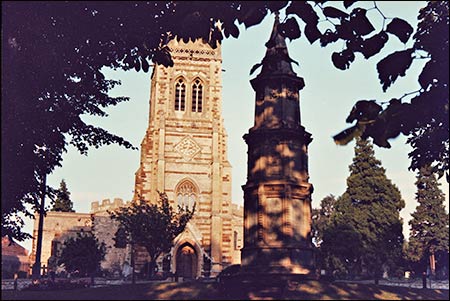1794 Five Bells, cast by Taylors of St. Neots , were placed in the tower. These were probably the first bells to be hung as there is no evidence of there being any earlier bells.
1818 The present heaviest bell (tenor) weighing 18cwt was added to make a ring of six.
1919 After this date the bells fell into poor repair and were not rung again until 1953
1953 Two light bells were added, each weighing 5cwt, to make the octave. These were also cast at Taylors, whose foundry had moved to Loughborough and is still the leading bell maker in the country. At the same time the fifth bell was found to be cracked and needed recasting while the third was also recast to blend in with the two new treble bells.
The bells were lowered in the tower to minimise the movement of the tower. A new metal frame replaced the old oak frame and all the bell fittings were replaced. All this work, together with the addition of a new clock face on the north side of the tower (facing the High Street) and the renovation of the church spire cost £3500 and was raised in 100 days. Most of the money came from the congregation, the townsfolk and the many family boot and shoe firms which had a close affinity with the town.
No major work has been required since 1953 as we now have a steeple keeper whose job is to look after the bells. They have been inspected by Taylors but no work was deemed necessary.
2003 Ringing took place at ground level until 2003 when a new ringing chamber was constructed at a higher level. The total cost for this work was nearly £15,000.
Wellingborough & Kettering News, January 3rd, 1880, transcribed by Kay Collins
Christmas Festivities were commenced in this village by the two brass bands serenading; the inhabitants at midnight on Christmas Eve. The members of the temperance band also sang carols and Christmas pieces. The bells were rung merrily at midnight on Christmas Eve, and again on Christmas morning their peals resounded gaily through the village. The ringers on Christmas Day succeeded in ringing a peal of 720 grandsire, with twelve bobs and six singles.
|
Wellingborough & Kettering News, December 31st, 1881, transcribed by Kay Collins
CAMPANOLOGY—Tuesday last was a red-letter day with the bell-ringers of this village, as it was the rendezvous of the ringers from Raunds, Titchmarsh, Irthlingborough, and Higham Ferrers. Some good changes were rung, although the ringers were rather unfortunate, a rope breaking as soon as the bells were raised. The keys of the clock loft were not at hand, and an hour and a half elapsed before a fresh start could be made. The peals rung were plain bob, Oxford bob, and London single. The following were the ringers:— Mr. J. Burton, Chelveston; Mr. J. Betts, Islip; Messrs. G. Thompson, W. Groome, W. Parker, A. Wright, J. Nutt, and T. Parker, Higham Ferrers; Messrs. W. H. and J. Upchurch, R. and J. Billings, F. Morris, and J. T. Allen, Titchmarsh; Messrs. A. Cuthbert, J. Houghton, M. Horner and R. Neville, Irthlingborough; Messrs. J. and H. Stubbs, J. Wilmer, G. Kirk, R. Pendred, W. Gilbert, and A. Coales, Raunds.
|
The Rushden Echo, 6th May, 1898, transcribed by Gill Hollis
Rushden Church Bells - It will be some time before another merry peal is rung upon the bells of St. Mary’s Church. The reason for this is to be found in the insecurity of the present supports. Owing to the condition of the bell-frame, it was thought advisable to call in Mr. John Taylor, of Loughborough, and he has reported to the effect that the frame is much too weak, the oscillation, when the bells are rung, being considerable. This oscillation, in Mr. Taylor’s opinion, is likely to injure the masonry of the tower. Risks of this nature are not to be taken, and there is no alternative to the purchase of a new bell frame, though for the present, the bells may be calmed. A new iron frame, with steel girders, would cost about £207, and though the church is at present hampered by the debt [words missing] new church, we feel sure that there is sufficient zeal and generosity among Rushden Churchmen to make short work of the special expense for the bells when the scheme for raising the money is put before them.
|
The Rushden Echo, 13th May 1898, transcribed by Kay Collins
CHURCH BELLS—At a meeting of the Church Council on Monday it was decided that, owing to the state of the bell frame, it would be necessary to discontinue for the present the custom of "ringing out" at deaths; but that the bell could be tolled as usual for funerals. No action will be taken at present with regard to the re-hanging of the bells, for which the estimated cost is £307.
|
Rushden Echo 12th December 1902, transcribed by Greville Watson
The Church Bells
On Thursday Mr Taylor, of Loughborough, of the well-known firm of bell founders, visited Rushden for the purpose of thoroughly inspecting the bells at the Parish Church. He was met by the Rector and Messrs G H Skinner, J Claridge, and R Marriott, members of the Church Council. After a long and careful examination of the bells all were agreed that in their present condition it would not be safe for the bells to be rung, as this would cause too much shaking of the frame. Mr Taylor estimated that the necessary repairs and alterations would cost £200.
|
Rushden Echo, 6th March 1908, transcribed by Kay Collins
Meeting of the Bellringers Association
The Wellingborough District of the Central Northamptonshire Association of Church Bellringers held their quarterly meeting at Higham Ferrers on Saturday. By permission of the Vicar the ringing of the bells was indulged in by various companies, and subsequently tea, served in the Church Room by the Higham ringers and their wives, was enjoyed, about 50 members being present from Northampton, Wellingboro’, Earls Barton, Rushden, Irchester, Doddington, Harrold, Irthlingboro’, Kettering, Isham, Sharnbrook, and Higham Ferrers.
A short business meeting followed, the Vicar (Rev G M Davidson) presiding.
It was resolved that the next quarterly meeting be held at Doddington in August, and that a special meeting be held at Wilby in May.
The secretary (Mr F Wilford) reported that the holding of a special meeting at Raunds in July to commemorate the 25th year of the Society’s existence was considered.
A vote of thanks was accorded the Vicar for his presence at the meeting, and for the use of the bells, and to the ladies for providing tea.
The Vicar, in the course of his remarks, said how pleased he was to welcome the ringers to Higham Ferrers, being fully convinced what a great amount of good the Association was doing in knitting the ringers together in one common brotherhood.
Ringing in various methods was indulged in until seven o’clock.
|
The Rushden Echo and Argus, 20th November, 1942, transcribed by Gill Hollis
Rushden Hears The Bells - Thanksgiving From St. Mary’s Church Tower
An old style chime before morning service brought the bells of St. Mary’s back to the vibrant joy of life at Rushden on Sunday, while through the town and beyond its borders people listened gladly to the iron voices of thanksgiving.
It was not a peal, because for many years the condition of the tower and frame has ruled out the turning of the bells.
Six clanging bells, however, can make good music. They were rung by male choristers from the chamber into which the west door opens, each man supporting his two-handed pull with the pedalling action of a foot inserted through a low-hanging hoop.
Some girl choristers, robed in readiness for the service, looked on admiringly. The Rector came in for a minute to see his ringers at work. A few people ambled through the churchyard and peeped inquisitively round the half-open door.
Through the inner door, when the second round of ringing began, it would be seen that most of the pews were already full. Outside, the black birds of the steeple wheeled round with fast-beating wings and returned for cautious landings. They are used to the clock chimes, but this new torrent of sound must have puzzled them.
Over The Highway
Over flagstones, broad steps and highway the west door looks out to the town War Memorial. Still ringed with flowers – many of them in memory of young men who have kept England free since 1939 – the monument was the centre of a cluster of people, some bending over poppies and inscriptions, others looking up to the steeple.
In the hollow beyond, Boy Scouts and Girl Guides were assembling for church parade. They, too, gazed towards the church. A few Home Guards, with flaps down over their ears, ambled through streets near the church. A ‘plane circled and swooped over the town, evidently joining in the celebration.
The ringers worked on. Someone relieved the tall man on the 23 cwt. Tenor bell, and the tall man exhibited hands well grimed with dust off the rope pads. He was perspiring, too.
Working on the second bell was Mr. William Ginns, a chorister for more than 50 years and a ringer for 46. Mr. Ginns is in charge of the bells, and had been up aloft with an oilcan to look them over. He had looked rather dubiously at the rope wheels, which were none the better in appearance for being idle since June 1940.
Back To Silence
A minute or so before eleven o’clock the concert of six bells ceased and was succeeded as in the old days by the “little” bell which beats out its lone message until the chiming of the hour.
Nearly half a mile away, the modern church of St. Peter has only one bell, small and undistinguished, but this was not to be left out of the national paean. It clapped industriously and gained the attention of a street or two.
Thus Rushden celebrated the Battle of Egypt. The bells resume their silent vigil – but not, think the people, for another forty months.
|
|
Northampton Chronicle & Echo, 12th June 1952
Rushden Bells Dedicated - £3,500 Subscribed in 100 days
Bells of Rushden Parish church, which have been silent for over 30 years, rang out in peals on Saturday after a service of dedication and thanksgiving. Re-cast, the bells have, been hung at a lower level in the spire which has also been restored, and an additional face has been added to the clock. Towards the cost, £3,500 was subscribed in 100 days. During the Coronation period the spire is being floodlit at night.
In an address after performing the dedication, the Bishop of Peterborough (Dr. Spencer Leeson) said a noble work had been carried through, a work which at one time seemed overpowering in its size and difficulty. An ordeal such as that always summoned up new energy and those outside the Church would be moved to inquire what it was that stirred hearts so mightily.
The music of church bells, said the Bishop, was a channel through which God spoke and the bells had a sacred purpose which seemed to be a gift peculiar to the English people. Elsewhere there were carillons and jangling bells but it was only England that had been given the mystery that came through the sound of church bells.
The service was conducted by the rector (the Rev. E. A. Green) and the lesson was read by the Rt. Rev. G. R. Vernon, vicar of Finedon.
Preceded by the choir and clergy, the Bishop moved to the west door for the dedication where the people's warden (Mr. G. E. V. Fleeman) presented the ropes of the bells to the Bishop. Rounds were then rung on the bells.
In the congregation were chairman of Rushden Urban Council (Mr. A. A. Allebone) and Mrs. Allebone, the Mayor and Mayoress of Higham Ferrers (Mr. and Mrs. John White) and members of the urban council.
Members of the Peterborough Diocesan Guild of Ringers rang peals for five hours after the service.
|
The Rushden Echo and Argus, 3rd April 1953, transcribed by Jim Hollis
Bells Will Record Church Gifts - And 100 Men May Ring Them
Bells shortly to be hung in the tower of St. Mary’s Rushden, will record for posterity a hundred days of generous giving which made possible the restoration work now in progress.
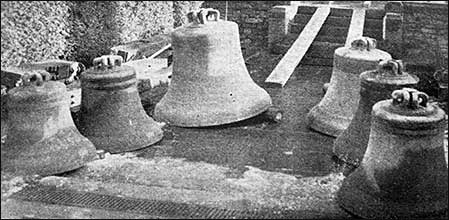 |
|
The bells waiting to go to Loughborough for re-casting
|
One of the two new bells which will supplement the previous six will have the inscription: “Spire and Re hanging Bells: £3,500 subscribed in 100 days. Deus Laudatus Rector: Edwin A. Green; Wardens: F. E. Andrews, G. E. V. Fleeman. Inspirer: Charles Clifton.”
The other new bell will record: “Bells re-hung Coronation Elizabeth II, June, 1953.”
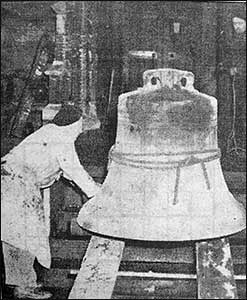 |
|
Sliding a bell down the church steps
|
The eight bells will be hung on a new steel frame completely spanning the tower and at the same time serving to strengthen it. Installation of the frame commences on April 13.
On examination one of the old bells was found to be slightly cracked. Re-casting was necessary, and another bell was re-cast for tuning purposes.
The weathervane for the top of the steeple is expected to be replaced in the next few days. Four re-gilded pinnacle vanes will be placed in copper holders designed to protect the stonework.
The clock mechanism is being transferred to the old bell chamber – which is having a new floor – and the bells will be housed in the old clock chamber 16 feet below.
So interested are ringers throughout the district in the re-hanging of the bells that after the dedication on Saturday, May 30, a hundred men may take it in turn to ring them during the evening. It is expected that the chiming of the clock will also be resumed on the day of dedication.
With the provision of a second dial for the clock and a considerable amount of other builders’ work which was not anticipated it is now realised that considerably more money will be required than was at first expected.
*Footnote: Mr. Clifton, sidesman and worker at St. Mary’s has been accorded this honour for the interest he has aroused and maintained among the younger bell-ringers.
|
The Rushden Echo and Argus, 1st May, 1953, transcribed by Gill Hollis
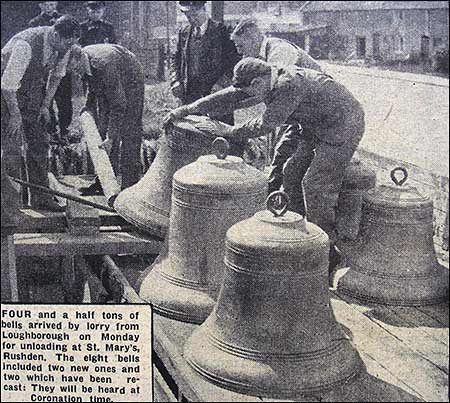 |
|
The bells return
|
Rushden hears the bells again
After something like half a century, the bells of St. Mary’s, Rushden, went into full action on Wednesday evening, when peals were rung to test the restoration work.
The six bells which served before the restoration had long been restricted to chiming, because of fears that the tower would not stand the strain of full ringing. It has now been shown, however, that re-hanging on a different principle and in a lower part of the tower was the answer to the problem.
Two bells have been added, and Rushden is in line with about 70 other churches of the Peterborough diocese – roughly one in five – which possess a complete octave.
Coming in from several towns and villages, the test ringers were experienced hands. At the end of the trials, however, the church’s own young team, which has been training at Higham Ferrers, enjoyed a pull.
Girl ringer
It was quite by accident that two Leicester Cathedral ringers took part in the test. Mr. Shirley Burton, making a business visit to the town on Tuesday, learned of the plans while chatting with Messrs. John Taylor and Co.’s bell-hanger and made a special journey from Leicester on Wednesday, bringing Miss Winifred Burton, aged 22, who recently accomplished her hundredth peal.
Father and daughter ring at Leicester Cathedral each Sunday, and a younger daughter, Eileen, rings at the Aylestone Church.
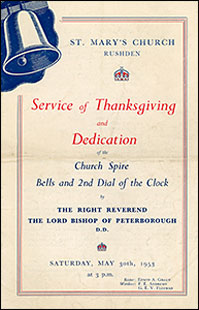 |
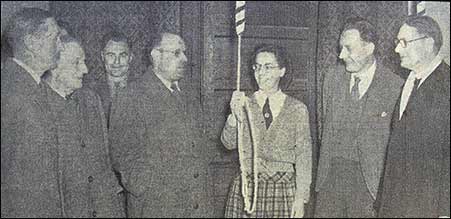 |
The re-hung bells are tested by Miss Winfred Burton, a ringer from Leicester Cathedral with (l-r) Mr G E V Fleeman (churchwarden), Mr Charles Clifton (“inspirer” of the restoration), Mr E E Whitmore (Master of Peterborough Diocesan Guild of Ringers), Mr Myatt (in charge of the rehanging) and
the Rev Edwin Green
|
The first rounds began at seven o’clock and led on to peals of Plain Bob, Superlative Grandsire, Stedman and Double Norwich. Mr. Mycett, the bell-hanger, with steeplejacks and other experts, checked-up in various parts of the tower, some going out to watch the effect on the flying buttresses.
Approved
The bells are in the key of E and Mr. E. E. Whitmore, of Stanwick, who is Master of the Peterborough Diocesan Guild of Church Bellringers, described them as a very musical peal which would be a credit to Rushden. Because of their new position well below the louvre windows, he said, their volume, as heard from the outside, was very moderate.
There will be no further ringing until the re-dedication service at the end of May. Work has begun on the filling-in of a window to form a background for an additional clock face, and on Wednesday bronze guards had yet to be fixed to keep birds out of the spire.
|
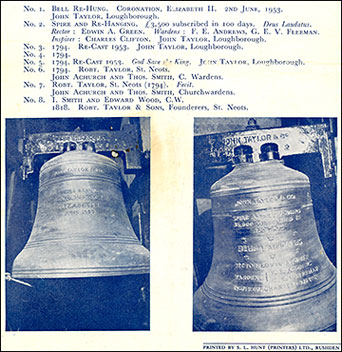 |
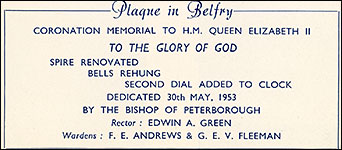 |
|
Plaque in the belfry - from the service sheet
|
|
